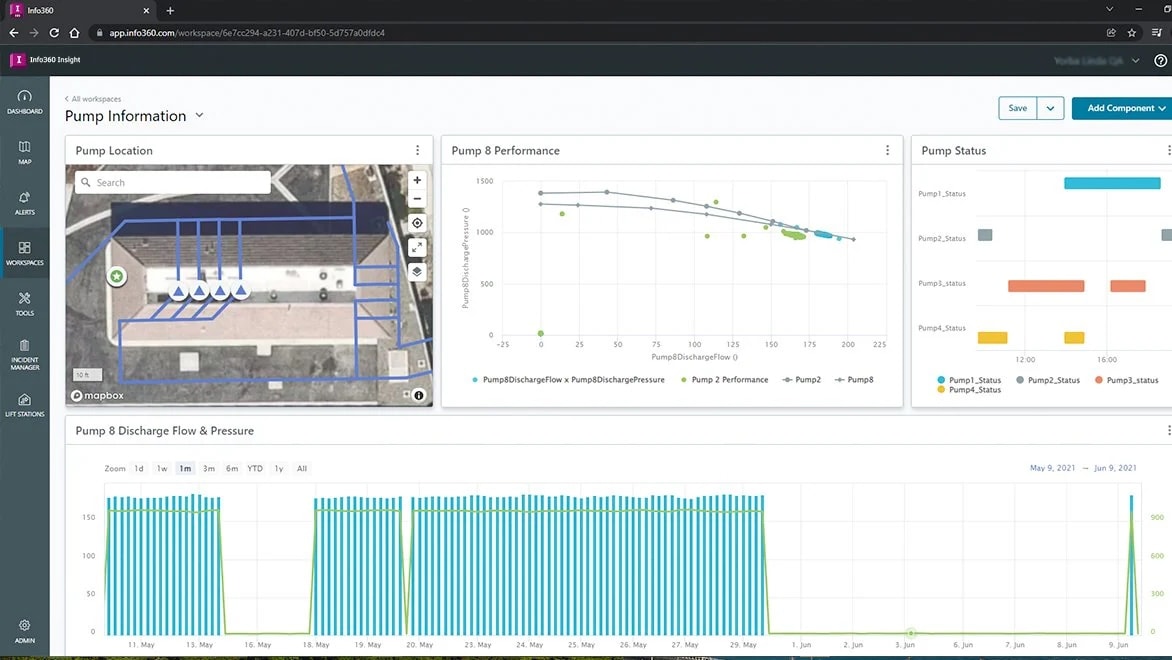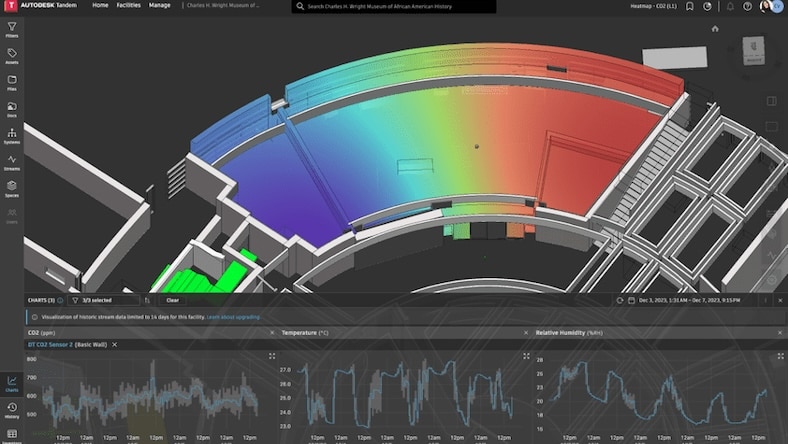& Construction

Integrated BIM tools, including Revit, AutoCAD, and Civil 3D
& Manufacturing

Professional CAD/CAM tools built on Inventor and AutoCAD
Operational analytics is a specialized branch of business analytics that optimizes operational performance by using real-time data and advanced technologies such as IoT, machine learning, and AI.
Operational analytics is essential in the architecture, engineering, construction, and operations (AECO) industry, optimizing real-time project management through continuous data monitoring and analysis from planning to maintenance. This method helps teams quickly identify inefficiencies, adapt to changes, and seize opportunities, enhancing efficiency across all project phases. Critical technologies such as the Internet of Things (IoT) and real-time data analytics give AECO professionals a competitive edge by maximizing the effectiveness of operational processes.
Set apart from traditional data analytics, which relies on historical data for strategy, operational analytics in the AECO sector utilizes real-time data for immediate action. This is vital in fast-changing project environments, where quick, informed decisions significantly affect project success and cost efficiency. Operational analytics enables a proactive management style so teams can adjust workflows, allocate resources efficiently, and quickly address challenges, minimizing downtime and improving project results.
Machine learning boosts operational analytics in AECO projects by enabling predictive analytics and automated decision-making. Machine learning algorithms help predict and mitigate project risks by forecasting bottlenecks and optimizing schedules, enhancing the precision of project delivery and overall operational efficiency. These algorithms adapt and improve their outputs based on continuous data input, meeting the evolving demands of AECO projects and fostering fresh management and execution techniques.
Operational analytics profoundly impacts facility management and building ownership by optimizing building design and operational efficiency. Facility managers and infrastructure owners can harness real-time data to fine-tune operational workflows, manage materials effectively, and strictly adhere to budgets and timelines. This approach enables the early detection of bottlenecks and inefficiencies, allowing for immediate interventions that prevent delays and minimize waste. Scenario-planning capabilities let stakeholders evaluate various operational strategies to find the most resource-efficient solutions, enhancing sustainability.
Operational analytics enhances building comfort by integrating occupant feedback and usage data. This allows facility managers to tailor building environments to meet the needs of users, adjusting aspects such as lighting, layout, and accessibility in response to actual usage patterns. This user-focused strategy increases occupant satisfaction and adds value by ensuring the building effectively serves its intended functional purposes.
Operational analytics give facility managers and building owners the tools to make informed, data-driven decisions that improve building management processes and outcomes. With real-time insights into building operations and occupant interactions, they can ensure their properties are operationally efficient and perfectly aligned with occupant needs, enhancing overall building performance and tenant satisfaction.
Artificial intelligence (AI) significantly enhances operational analytics in architecture by advancing predictive analytics into prescriptive solutions. AI algorithms process vast datasets to forecast and proactively address potential issues in architectural projects, such as predicting the failure of construction components and scheduling maintenance to prevent downtime. This capability boosts operational efficiency, ensuring smooth project execution and cost-effective outcomes.
AI improves operational efficiency in architectural practices by automating routine tasks, enabling professionals to focus on higher-value activities. AI frees up time and resources by streamlining data entry, optimizing schedules, and conducting compliance checks. This shift allows teams to concentrate on operational optimization and effective project management, increasing overall productivity and improving job satisfaction.
AI drives more sustainable and efficient construction by optimizing material usage and energy consumption. AI tools minimize waste by enhancing material cuts and using simulations to design energy-efficient buildings, supporting the industry’s shift toward sustainability. Through these innovations, AI reduces costs and promotes environmental sustainability in construction practices.
Software for operational analytics offers transformative benefits that empower AECO organizations to optimize their performance and refine at scale, including:
Autodesk Info360 Insight allows facility managers and architects to process and analyze data instantly, enabling quick adaptations to operational changes and accelerating decision-making.
Tools like Autodesk Tandem and Eptura automate and help streamline AECO processes, reducing manual labor and minimizing errors to optimize workflow and boost operational efficiency.
Operational analytics platforms like Autodesk Tandem and Eptura are designed to scale, handling increased data volumes and complex analytics effortlessly as business needs grow.
Using Autodesk Info360 Insight to pinpoint inefficiencies helps organizations optimize resources, reduce costs, and enhance productivity, leading to substantial financial savings.
STANTEC
A water utility company uses Autodesk Info360 Insight to modernize water pump maintenance and reduce carbon emissions.
WINDOVER CONSTRUCTION
A construction management company uses Autodesk Tandem to deliver data-rich digital twins and delight clients.
CHARLES H. WRIGHT MUSEUM
A museum of African American history uses Autodesk Revit and Autodesk Tandem to enter the era of proactive facility maintenance.
Stay up-to-date on the latest stories of AECO professionals harnessing the power of operational analytics to manage water systems efficiently.
Learn how water utilities are navigating the challenges of climate change, aging infrastructure, and conservation with the power of data and technology.
Discover how to help streamline water and wastewater system analysis with Autodesk Info360 Insight and Autodesk Info360 Plant.
See how an augmented architecture firm uses operational analytics to stay at the forefront of creativity.
Adopt a cloud-based platform for AECO workflows and ensure data is accessible and integrated throughout project phases.
Explore the digital thread connecting architects, engineers, and builders to real-time project data from design to construction.
Operational analysis is essential for infrastructure owners and facility managers, providing critical insights to enhance operational efficiency. This approach involves collecting and analyzing data across various operational areas, using process mapping to clearly visualize workflows, and employing key performance indicators for effectiveness assessment. It helps identify inefficiencies, bottlenecks, and quality issues, enabling the development of targeted solutions to help streamline operations, reduce waste, and improve service delivery. These solutions are implemented and continuously monitored to ensure they meet desired outcomes, optimizing infrastructure management and operations.
Operational analytics has been widely adopted across sectors to enhance efficiency and inform real-time decision making. In manufacturing, it helps streamline production and supply chain management, while in health care, it optimizes hospital bed allocation and staff scheduling to improve patient care. Retail businesses apply it to manage inventory and customize shopping experiences, and transportation and logistics firms use it for route optimization and fleet management. Financial services use operational analytics for risk management and fraud detection, and telecommunications companies employ it to maintain network stability and quality of service. Lastly, energy firms use it for grid management and to adapt to fluctuating energy demands.
Operational analytics and data analytics serve distinct purposes within an organization. Operational analytics is specifically geared toward enhancing and optimizing day-to-day business operations through real-time data, enabling immediate decision-making and rapid response to operational issues. It typically uses technologies such as IoT to monitor and analyze processes as they happen. In contrast, data analytics has a broader scope, analyzing larger datasets to reveal insights and patterns for strategic decision making. This type of analytics is not confined to real-time data and often supports long-term planning with its predictive and prescriptive capabilities.






